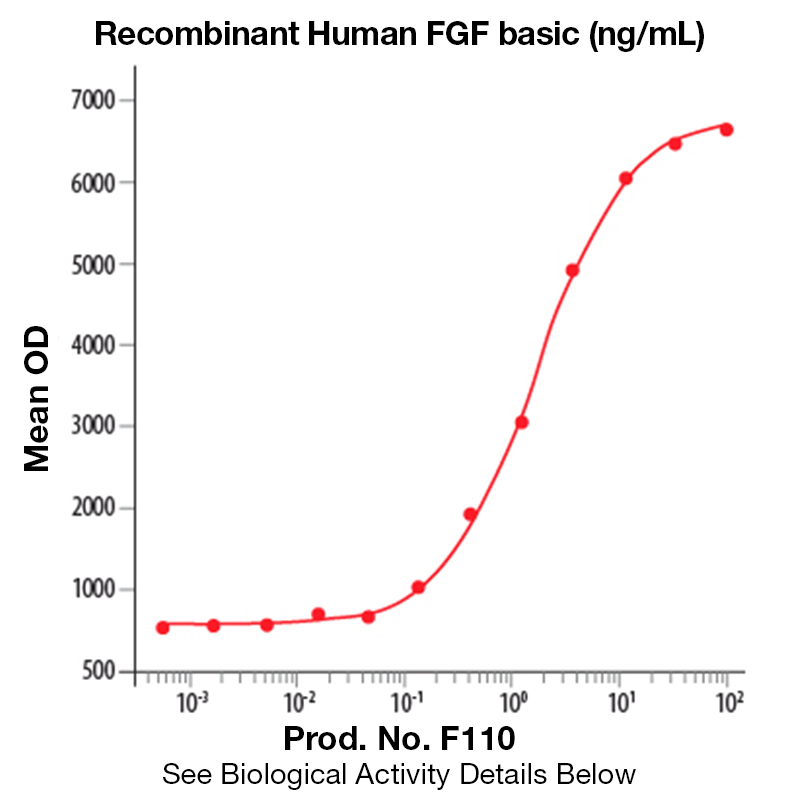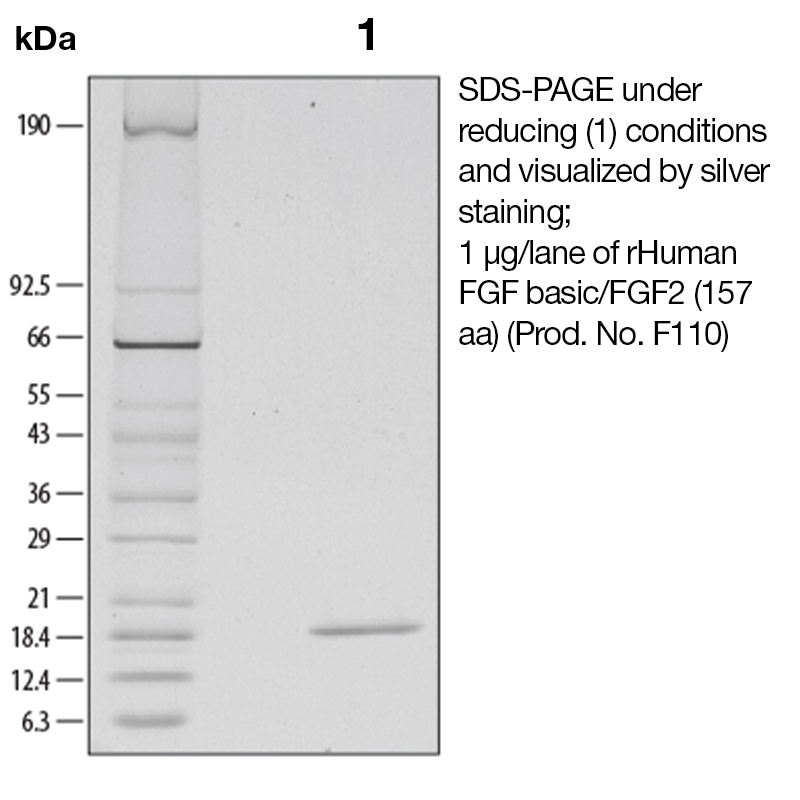Recombinant Human FGF-Basic
Data
- -
- -
BackgroundBasic fibroblast growth factor (bFGF), also known as FGF-2 and FGF-β, is a non-glycosylated heparin binding growth factor and member of the FGF family of mitogenic proteins. Members of this family play a central role during prenatal development, postnatal growth and regeneration of a variety of tissues, by promoting cellular proliferation and differentiation (1). bFGF is expressed in the brain, pituitary, kidney, retina, bone, testis, adrenal gland, liver, placenta, and monocytes, epithelial and endothelial cells. It is secreted by mechanisms other than the classical protein secretion pathway due to the lack of a signal peptide. Acidic FGF (aFGF) and bFGF bind to the same high affinity receptors (2). Binding of bFGF to heparin or cell surface heparan sulfate proteoglycans is a prerequisite for ligation of bFGF to these receptors. aFGF and BFGF have a similar range of biological activities which are implicated in several important physiological and pathological processes, such as embryonic development and differentiation, morphogenesis, angiogenesis, and wound healing (3-4). Protein DetailsPurity >97% by SDS-PAGE and analyzed by silver stain. Endotoxin Level <0.1 EU/µg as determined by the LAL method Biological Activity The biological activity of Human FGF-basic was monitored in a mitogenic assay by measuring the FGF basic dependent <sup>3</sup>H-thymidine incorporation in quiescent NR6R-3T3 fibroblasts (Rizzino, A. et al., 1988. Cancer Research 48:4266 - 4271). The expected ED<sub>50</sub> for this effect is typically 0.1 - 0.25 ng/ml. Protein Accession No. NP_001997 Amino Acid Sequence gtmaagsit tlpalpedgg sgafppghfk dpkrlyckng gfflrihpdg rvdgvreksd phiklqlqae ergvvsikgv canrylamke dgrllaskcv tdecffferl esnnyntyrs rkytswyval krtgqyklgs ktgpgqkail flpmsaks N-terminal Sequence Analysis Gly132 State of Matter Solution Predicted Molecular Mass The predicted molecular weight of Recombinant Human FGF-Basic is Mr 17.4 kDa. However, the actual molecular weight as observed by migration on SDS-PAGE is 19 kDa (reducing conditions). Predicted Molecular Mass 17.4 Formulation This recombinant protein solution was 0.2 µm filtered and formulated in Tris and NaCl. Storage and Stability This protein is stable for > twelve months when stored at -20°C to -70°C. After thawing and addition of a carrier protein, this protein may be stored at 2°C to 8°C for one month or for up to three months at -20°C to -70°C in a manual defrost freezer. Avoid Repeated Freeze Thaw Cycles. See Product Insert for exact lot specific storage instructions. Country of Origin USA Shipping Next Day 2-8°C NCBI Gene Bank References & Citations1. Swain, JL. et al. (1991) Developement 111: 741 2. Grevers, G. et al. (1997) Laryngorhinootologie 76: 421 3. Bühring, HJ. et al. (2007) Differentiation. 75(4):279-91 Certificate of AnalysisIMPORTANT Use lot specific datasheet for all technical information pertaining to this recombinant protein. |
Related Products
- -
- -
Prod No. | Description |
|---|---|
F149 | |
F1105 | |
F107 | |
F110 | |
F1022 | |
F1027 |




